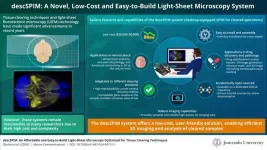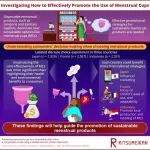(Press-News.org) Chicago (July 2, 2024) — A new study found that school-aged children who consumed more isoflavones from soy foods exhibited better thinking abilities and attention. These findings pave the way for future research aimed at unraveling how soy foods can positively impact children's cognitive abilities.
Isoflavones are naturally occurring compounds found in various plants, particularly soybeans and soy products. Although previous research in adults has suggested that soy isoflavones can improve memory, the benefits haven’t been studied well in children.
“Soy foods are often not a regular part of children’s diets in the United States,” said Ajla Bristina, a neuroscience doctoral student at the University of Illinois Urbana-Champaign. “Our study adds evidence of the importance of nutrients found in soy foods for childhood cognition.”
Bristina will present the findings at NUTRITION 2024, the flagship annual meeting of the American Society for Nutrition held June 29–July 2 in Chicago.
To examine the potential benefits of soy isoflavones, the researchers examined previously available data from a cross-sectional study that included 128 children ages 7 to 13. They used information from 7-day diet records to calculate each child’s average dietary intake, including the amounts of macronutrients, micronutrients, vitamins and isoflavones consumed. To assess the children’s general intellectual ability, the researchers used a set of pencil and paper tests adjusted for grade level. They also measured attentional abilities using a computerized task known as the flanker task while electroencephalographic (EEG) activity was recorded and used to measure information processing speed and attention.
“No other studies have examined the association between soy isoflavones and attentional abilities using EEG or similar measures to record electrical activity generated by the brain,” said Bristina.
Overall, the analysis revealed that the children in the study tended to consume low amounts of isoflavone-containing soy foods. However, those who did consume more soy foods showed faster responses during the attentional tasks and exhibited faster processing speed. No association was observed between soy isoflavone intake and general intellectual ability.
“The children in our study consumed an average of 1.33 mg of isoflavones per day, which while relatively low, aligns with previously reported values for the United States,” said Bristina. “Soy consumption for individual participants ranged from 0 to 35 mg/day. To put this into perspective, an 8 fl. oz serving of soy milk provides about 28 mg of isoflavones, a serving of tofu provides about 35 mg and half a cup of steamed edamame provides about 18 mg of isoflavones.”
Bristina says that snacks like roasted edamame, soynuts or soymilk are a good way to incorporate more soy into the diet. Tofu, tempeh or soy-based nuggets are also good options for meals.
“Correlational studies like this are only the first step,” said Bristina. “To better understand the effects of eating soy foods on children’s cognitive abilities and the precise amount of isoflavone intake necessary to elicit faster response times will require intervention approaches.” To find out more, the research team recently began a clinical trial examining the effects of soy foods on thinking abilities, sex hormones, metabolic health and gut health.
Bristina will present this research at 8:12-8:24 a.m. CDT on Tuesday, July 2, during the Nutritional Neuroscience: Nutritional Effects on Cognition and Disease Severity Across the Lifespan session in McCormick Place (abstract; presentation details).
Please note that abstracts presented at NUTRITION 2024 were evaluated and selected by a committee of experts but have not generally undergone the same peer review process required for publication in a scientific journal. As such, the findings presented should be considered preliminary until a peer-reviewed publication is available.
About NUTRITION 2024
NUTRITION 2024 is the flagship meeting of the American Society for Nutrition and the premier educational event for nutritional professionals around the globe. NUTRITION brings together lab scientists, practicing clinicians, population health researchers, and community intervention investigators to identify solutions to today’s greatest nutrition challenges. Our audience also includes rising leaders in the field – undergraduate, graduate, and medical students. NUTRITION 2024 will be held June 29–July 2, 2024 in Chicago. https://nutrition.org/N24 #Nutrition2024
About the American Society for Nutrition (ASN)
ASN is the preeminent professional organization for nutrition research scientists and clinicians around the world. Founded in 1928, the society brings together the top nutrition researchers, medical practitioners, policy makers and industry leaders to advance our knowledge and application of nutrition. ASN publishes four peer-reviewed journals and provides education and professional development opportunities to advance nutrition research, practice, and education. Since 2018, the American Society of Nutrition has presented NUTRITION, the leading global annual meeting for nutrition professionals. http://www.nutrition.org
Find more news briefs from NUTRITION 2024 at: https://www.eurekalert.org/newsroom/nutrition2024/home.
###
END
About The Study: The Massachusetts statewide standing order policy was associated with a 32% increase in emergency contraceptive fills at pharmacies versus comparison states. After the policy, fills for prescription-only ulipristal more than doubled and accounted for the observed increases in fills for emergency contraceptives.
Corresponding Author: To contact the corresponding author, Dima M. Qato, Pharm.D., M.P.H., Ph.D., email qato@usc.edu.
To access the embargoed study: Visit our For The Media website at this link https://media.jamanetwork.com/
(doi:10.1001/jama.2024.11715)
Editor’s ...
Washington, D.C.—Researchers have detected anaerobic and aerobic bacteria in commercial tattoo and permanent makeup inks. The findings, reported in Applied and Environmental Microbiology, a journal of the American Society for Microbiology, demonstrate that the inks could be a source of human infections. The new study is particularly notable as it is the first to investigate the presence of anaerobic bacteria in commercial tattoo inks.
“Our findings reveal that unopened and sealed tattoo inks can harbor anaerobic bacteria, known to thrive in low-oxygen environments like ...
Waltham — July 2, 2024 — American Indian/Alaska Native (AI/AN) women with breast cancer have consistently lower rates of breast reconstruction after mastectomy compared to non-Hispanic White women, reports a paper in the July issue of Plastic and Reconstructive Surgery®, the official medical journal of the American Society of Plastic Surgeons (ASPS). The journal is published in the Lippincott portfolio by Wolters Kluwer.
"Despite an upward trend in reconstruction, AI/AN women continue to be less likely to undergo breast reconstruction," comments Jane Hui, MD, MS, ...
A modeling study suggests that influential neighbors can be as effective as despotic leaders at promoting social cooperation. Prosocial behaviors can be difficult to sustain in large societies over the long term, as people give into the temptation to defect to strategies that prioritize the wellbeing of themselves and their immediate family. Stefani Crabtree and colleagues constructed a general theoretical framework to explore how cooperation could arise and be maintained in a large society. The authors explore three possible ...
Mill Valley, CA – June 18, 2024 SRF has established a dedicated account to support research regarding SYNGAP1 missense variants. This account is being launched with a $10,000 donation from Dennis and Janet Nordmoe. This is a cause close to their hearts, as their granddaughter Olivia was diagnosed with SYNGAP1-Related Disorder (SRD) caused by a missense variant earlier this year.
Missense Research: Neglected to Date
“Most diagnosed SYNGAP1-Related Disorder (SRD) patients have protein truncating variants (PTV) as opposed to missense variants. Virtually all PTVs are assumed to have the ...
Three-dimensional (3D) imaging of organs and tissues is vital as it can provide important structural information at the cellular level. 3D imaging enables the accurate visualization of tissues and also helps in the identification of pathological conditions. However, achieving successful 3D imaging necessitates specific prerequisites, including the preparation of 'cleared' tissue samples—biological specimens rendered transparent by removing light-scattering components like lipids to ...
In recent decades, single-use plastics have pervaded modern societies, causing a significant surge in plastic pollution that exacts a heavy toll on our environment. Addressing this issue requires prioritizing sustainable alternatives to single-use plastics wherever feasible.
Disposable menstrual products are a notable contributor to plastic waste, with billions of sanitary napkins and tampons being discarded every year. Despite the availability of sustainable options like menstrual cups (MCs), consumer preference for single-use products ...
Who’s stronger? A solitary leopard or cackle of hyenas? And which is best at getting along with humans?
University of Copenhagen researchers closely studied this in a large East African natural area surrounded by rural settlements. The study demonstrates that the presence of humans has a direct impact on the competitive relationship between the two large predator species: leopards (Panthera pardus) – the iconic spotted feline and the spotted hyena (Crocuta crocuta) – a kleptoparasite and pack hunter known for its comical ...
The reality of the climate impact of long-distance passenger travel has been revealed in new research from the University of Leeds.
Despite only accounting for less than 3% of all trips by UK residents, journeys of more than 50 miles (one way) are responsible for 70% of all passenger travel-related carbon emissions.
The disparity is even greater when international travel is singled-out: international journeys are only 0.4% of total trips but are responsible for 55% of emissions.
The new research, published today in the journal Nature Energy, also shows ...
Whole genome sequencing has improved clinical care of some children with cancer in England by informing individual patient care.
New research from the Wellcome Sanger Institute, Cambridge University Hospitals NHS Trust, Great Ormond Street Hospital, and the University of Cambridge, supports the efforts to provide genome sequencing to all children with cancer and shows how it can improve the management of care in real-time, providing more benefits than all current tests combined.
The study, published today (2 July) in Nature Medicine, ...



